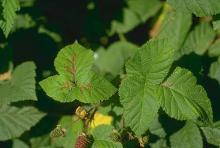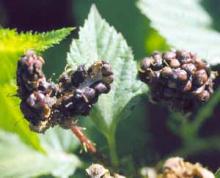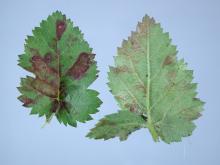See:
Rose (Rosa spp.) and hybrids - Downy Mildew
Cause Peronospora rubi and/or Peronospora sparsa, (the former has been reported from the PNW) a fungus-like organism that infects many caneberries (Rubus spp.), especially blackberry and 'Boysenberry'. The disease is not common on red raspberry. The blackberry cultivars Black Butte and Loch Ness are susceptible. This organism overwinters primarily as a systemic infection of canes, crowns, roots, and buds. The disease cycle starts each spring with the production of infected shoots from infected root, crown, and cane buds. Unfolding leaves are invaded during warm, wet conditions. Secondary infections of flowers and developing berries during wet, warm weather are initiated from flowering to harvest primarily by conidia produced on diseased shoots. Weather parameters that are associated with increased disease include months where the temperature is between 59°F and 68°F for 10 or more hours and months when it rains more than 11 days. Diseased berries then become an important source of inoculum for new cycles of berry infection. After harvest, infection of developing primocanes lying on the ground continues by internal mycelial growth and spore infection. Propagation of systemically infected nursery stock is another way fields can become severely infected. When identifying infected but symptomless plants, sampling newly emerging leaves at early bud break will result in an 80 to 90% detection frequency in susceptible cultivars.
Cross inoculations with isolates from either rose or Rubus sp. show they can infect the other host.
Symptoms In summer to autumn, small, conspicuous, irregularly shaped patches appear on upper leaf surfaces, starting near the petiole then following leaf veins. Patches are yellow initially, becoming a deep wine red with a brownish edge and brownish discoloration near and alongside veins. Red streaking on stems and petioles indicate systemic infection. The organism attacks fruits, sepals, and pedicels of 'Boysenberry', causing fruit to become dry and shrivelled (dry cell syndrome). Berries also may split and appear to be two berries on one pedicel. The dry-berry mite and sunburn can also cause a dry berry condition.
Cultural control
- Use certified nursery stock free of the pathogen.
- Practice early primocane control through chemical burning.
- Reduce or eliminate overhead irrigation.
- Practice good weed control.
- Eliminate other hosts, such as wild blackberries and roses, close to fields.
Chemical control Recommended only for plantings confirmed as diseased. Fungicides can help limit losses but will not eradicate the pathogen from plants. Tank-mix and/or alternate products from different groups with different modes of action to prevent the build-up of resistant fungi.
- Aliette WDG at 5 lb/A sprayed over the trellis twice in fall before fall rains and twice in spring. Do not mix with surfactants or foliar fertilizers. Do not apply within 60 days of harvest. Group P7 fungicide. 24-hr reentry.
- Fosphite at 1 to 3 quarts/A. Do not use copper products within 20 days of treatment and do not use spray adjuvants. Group P7 fungicide. 4-hr reentry.
- OxiPhos at 2.5 to 5 quarts/A as a foliar spray. Group P7 fungicide. 4-hr reentry.
- Phostrol at 4.5 pints/A is registered for root rot control and may be effective for this disease. Group P7 fungicide. 4-hr reentry.
- Rampart at 1 to 3 quarts/100 gal water/A. Group P7 fungicide. 4-hr reentry.
- Ridomil Gold Copper at 2 lb/A and repeat in 7 days. Do not apply with an adjuvant. Can be applied the day of harvest. Group 4 + M1 fungicide. 48-hr reentry.
- Tanos at 8 to 10 oz/A plus a copper-based fungicide is registered for this crop but not this disease. It has activity on other downy mildews on other crops and may be useful on blackberry. Can be used day of harvest. Group 11 + 27 fungicide. 12-hr reentry.
Reference Ivey, M. L. L. and Madrid, A. M. J. 2024. Sampling for the Early Detection of Peronospora sparsa in Blackberry Nursery Stock Plants. Plant Health Progress, 25:4-8.
Kim, K.S., Beresford, R.M., and Walter, M. 2013. Development of a disease risk prediction model for downy mildew (Peronospora sparsa) in boysenberry. Phytopathology 103:50-56.





